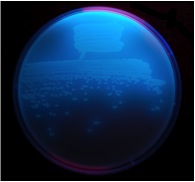
Sequences derived from the single amplified genomes in the study were mapped to
reference genomes such as P. fluorescens(Image by Ninjatacoshell / Wikimedia Commons)
Single cell genomicsis a method used by researchers to get around the research roadblock thrown up by the need for large amounts of microbial DNA in order to do traditional sequencing techniques. In this process, a single cell isolated from an environmental sample is amplified to make millions of copies of the microbial genome for sequencing.
One challenge single cell genomics researchers face, however, is that the reagents used in the multiple displacement amplification process along with the phi29 polymerase are contaminated with DNA that also ends up being amplified along with the target DNA, ultimately impacting the technique’s effectiveness in characterizing unknown microbial genomes.
In a report published October 20, 2011 in PLoS ONE, DOE JGI Microbial Genomics Program head TanjaWoyke and Process Optimization head Jan-Fang Cheng led colleagues and longtime collaborators from the Bigelow Laboratory for Ocean Sciences in testing UV-irradiation of up to 90 minutes as a way to standardize UV treatment protocols for removing the contaminant DNA that comes in MDA reagents without affecting enzyme activity or introducing potential biases into the process.
“From the analysis of genomic sequence data of >100 Escherichia coli single cells, we demonstrate the optimal range of UV treatment of MDA reagents for efficiently removing contaminant DNA without a significant reduction of the Phi29 activity or introducing additional single cell genome coverage bias or artifacts,“ the team wrote in their paper.